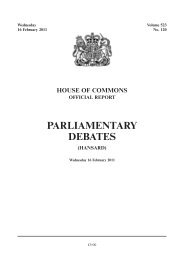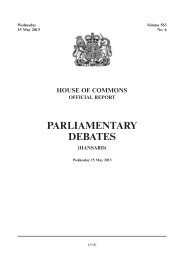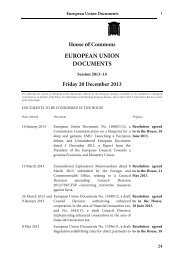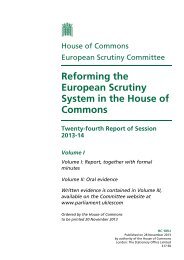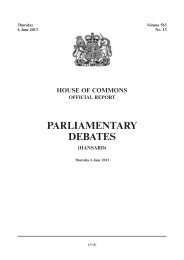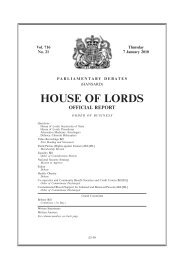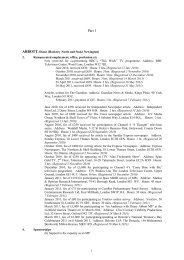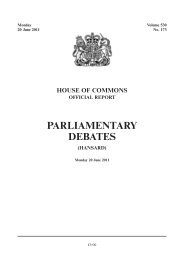Ticketing and Concessionary Travel on Public Transport - United ...
Ticketing and Concessionary Travel on Public Transport - United ...
Ticketing and Concessionary Travel on Public Transport - United ...
You also want an ePaper? Increase the reach of your titles
YUMPU automatically turns print PDFs into web optimized ePapers that Google loves.
Ev 94 <strong>Transport</strong> Committee: Evidence<br />
magnetic ticket technology now in use was not designed for nati<strong>on</strong>al rail revenue c<strong>on</strong>trol purposes <str<strong>on</strong>g>and</str<strong>on</strong>g> does<br />
not necessarily c<strong>on</strong>duct correct checks <strong>on</strong> l<strong>on</strong>g distance tickets or visually cancel tickets. Manually<br />
c<strong>on</strong>trolled gates will be much used <str<strong>on</strong>g>and</str<strong>on</strong>g> come to dominate <str<strong>on</strong>g>and</str<strong>on</strong>g> undermine the whole c<strong>on</strong>trol principle. This<br />
can already be observed at a number of stati<strong>on</strong>s, where the manual gate facility is usually under pressure,<br />
is often a cause of poor customer service <str<strong>on</strong>g>and</str<strong>on</strong>g> provides <strong>on</strong>ly a cursory ticket check.<br />
18. As there are no reliable estimates of fare evasi<strong>on</strong> or ticket-less travel, the financial justificati<strong>on</strong> for<br />
these schemes is not self-evident. Where a proper survey of the level <str<strong>on</strong>g>and</str<strong>on</strong>g> nature of ticket-less travel has been<br />
undertaken, it will be possible better to assess the case for the implementati<strong>on</strong> of any automatic ticket gate<br />
schemes, as these represent a substantial investment <str<strong>on</strong>g>and</str<strong>on</strong>g> have significant <strong>on</strong>going costs. Evidence that such<br />
equipment is guaranteed to reduce ticket-less travel is open to debate. It is inappropriate to extrapolate any<br />
early trends <strong>on</strong>to all the stati<strong>on</strong>’s revenue to show the assumed benefit from gating. In reality revenue may<br />
not in fact change substantially in the l<strong>on</strong>ger term, <str<strong>on</strong>g>and</str<strong>on</strong>g> in a comparis<strong>on</strong> of the revenue trends at gated <str<strong>on</strong>g>and</str<strong>on</strong>g><br />
un-gated stati<strong>on</strong>s it can be diYcult to identify significant diVerences. Much of the revenue generated at these<br />
stati<strong>on</strong>s is likely to be the mopping up of local fares that are not being adequately c<strong>on</strong>trolled <strong>on</strong> train, <str<strong>on</strong>g>and</str<strong>on</strong>g><br />
there is no benefit to the l<strong>on</strong>ger distance business. Recent surveys in the L<strong>on</strong>d<strong>on</strong> area suggest that gates can<br />
reduce local ticket-less travel by 50% but do not eliminate it. The near fully gated system <strong>on</strong> the L<strong>on</strong>d<strong>on</strong><br />
Underground still has a residual 3% evasi<strong>on</strong> rate.<br />
19. The successful adaptati<strong>on</strong> of ticket gates to deal eVectively with other ticket media such as mobile<br />
ph<strong>on</strong>es or paper bar-code recogniti<strong>on</strong> is still unproven at this stage, which is a cause of some c<strong>on</strong>cern as<br />
these are seen as essential developments in distributi<strong>on</strong> that existing <str<strong>on</strong>g>and</str<strong>on</strong>g> new gating schemes introduced by<br />
a number of TOCs may not be equipped to deal with. Alternatively the process of upgrades may prove costly<br />
or diYcult to progress. This may inhibit the use of new distributi<strong>on</strong> channels which do not create tickets that<br />
c<strong>on</strong>form to current magnetic (or proposed smartcard) st<str<strong>on</strong>g>and</str<strong>on</strong>g>ards. Any moves towards more yield<br />
management systems that specify which train must be used are not well supported by gate technology or<br />
comm<strong>on</strong> access c<strong>on</strong>trol. Some TOCs may be reluctant to h<str<strong>on</strong>g>and</str<strong>on</strong>g>le more customers through manual gates<br />
because of ticket medium compatibility problems or the ability of gate software to make correct validity<br />
assessments <strong>on</strong> magnetic tickets. There is likely therefore to be a better case to be made for investment in<br />
people <strong>on</strong> train <str<strong>on</strong>g>and</str<strong>on</strong>g> improved staV performance than in this sort of equipment. At present there is a tendency<br />
am<strong>on</strong>g heavy rail operators to invest quite heavily in enforcement through technology that is not necessarily<br />
appropriate to their business while neglecting to spend m<strong>on</strong>ey <strong>on</strong> staV <str<strong>on</strong>g>and</str<strong>on</strong>g> their training <str<strong>on</strong>g>and</str<strong>on</strong>g> development<br />
in revenue protecti<strong>on</strong> work. This also results in the not unusual spectacle of expensive ticket gates, which<br />
cannot be used in unattended or unsupervised mode, left open for lack of staV or inadequately manned by<br />
c<strong>on</strong>tract pers<strong>on</strong>nel.<br />
Richard Malins<br />
March 2007<br />
Supplementary memor<str<strong>on</strong>g>and</str<strong>on</strong>g>um from <strong>Transport</strong> Investigati<strong>on</strong>s Ltd (TPT 12a)<br />
Revenue Protecti<strong>on</strong> <strong>on</strong> the Railway Network<br />
1. A starting point for any discussi<strong>on</strong> <strong>on</strong> this topic should be an estimate of the extent <str<strong>on</strong>g>and</str<strong>on</strong>g> nature of fare<br />
evasi<strong>on</strong> <strong>on</strong> the railway business, to define the problem before deciding <strong>on</strong> the measures relevant to solving it.<br />
2. The reality is that there is very little accurate evidence <strong>on</strong> this subject <str<strong>on</strong>g>and</str<strong>on</strong>g> the estimates brought before<br />
the Committee were more speculative than real. It is my belief that most of the quoted figures in the public<br />
domain are based <strong>on</strong> surveys that are statistically flawed, both in the sampling techniques used <str<strong>on</strong>g>and</str<strong>on</strong>g> in any<br />
weighting (or n<strong>on</strong>e) applied to the figures. Some are little more than anecdotal or informed guesswork.<br />
Extrapolati<strong>on</strong> of numbers from stati<strong>on</strong> based activities can be misleading, while others do not adequately<br />
take into account diVerences in fare values <str<strong>on</strong>g>and</str<strong>on</strong>g> revenue weights for diVerent types of journey. It is generally<br />
recognised for example that short journeys tend to be more pr<strong>on</strong>e to n<strong>on</strong>-payment, but such figures are then<br />
applied across the whole business, particularly to l<strong>on</strong>ger distance journeys with higher revenue values.<br />
3. The figures being quoted by ATOC <str<strong>on</strong>g>and</str<strong>on</strong>g> Passenger Focus, of 5–8% of revenue or £400 milli<strong>on</strong>, are<br />
estimates without qualificati<strong>on</strong> as to how much of this is active fare evasi<strong>on</strong> <str<strong>on</strong>g>and</str<strong>on</strong>g> how much is unpaid travel<br />
caused by ticket retailing failures. There is also likely to be some overstatement due to the lack of revenue<br />
value weighting by journey type. My pers<strong>on</strong>al estimate, based <strong>on</strong> such informati<strong>on</strong> as is available to me, is<br />
that although there are places where fare evasi<strong>on</strong> reaches these levels, that figure is not typical of the network<br />
as a whole, while the areas of c<strong>on</strong>spicuous retailing failures are <strong>on</strong> local services where traYc has outgrown<br />
the ability of the ticketing systems to cope. These do not actually account for the bulk of railway revenue.<br />
4. The degree of c<strong>on</strong>fusi<strong>on</strong> about the extent of fare evasi<strong>on</strong> is evident from statements by First Group,<br />
with the Chairman claiming losses <strong>on</strong> its FCC rail franchise of £40 milli<strong>on</strong>, which represents 1 passenger in<br />
6 not paying a fare, while the TOC’s MD told the Committee the loss was around 5% or £15 milli<strong>on</strong>. Claims



